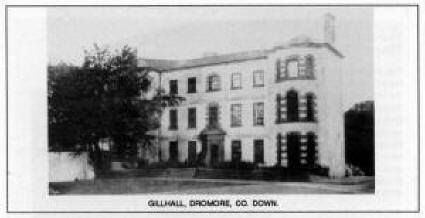 |
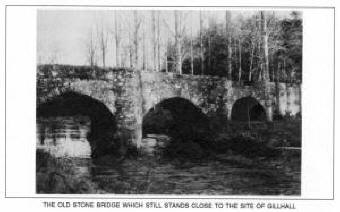 |
|
Gillhall, Dromore
Co. Down |
The old bridge
which still stands close to the site of Gillhall |
GILLHALL DESTROYED BY FIRE
HAS THE GHOST BEEN LAID?
(Taken from a report in The Leader, June 6, 1969).
Since the early hours of last Sunday morning
only the shell remains of the centuries old Gillhall mansion
on the outskirts of Dromore, which owes its chief claim to
fame to the fact that it is alleged to have been inhabited
by a ghost. During the night it was gutted by a fire which
was still smouldering many hours later.
On Monday the wreckage was searched by
forensic science experts. The
mansion was occupied by the R.A.F. during the last war but
since then it has been standing gaunt and empty.
THE GHOSTLY VISIT
John Johnston, who assumed the name of Magill
and became Sir John Magill of Gillhall, married Arabella
Hamilton. Her sister, Nicola Sophia, married Sir Tristram
Beresford of Coleraine, in February, 1688, he dying on the
16th June, 1701, having had issue by her one son and a
daughter. His widow, Lady Beresford, married secondly in
April, 1704, Lieut. - Colonel, afterwards Lieut.-General
Gorges of Kilbrew. This lady was the heroine of the Gillhall
ghost story. Lady Beresford was a
cousin of John Le Peor, second Earl of Tyrone. She and her
cousin were brought up together and had as their tutor a
confirmed Deist, who induced both his pupils to adopt his
principles. They became fast converts and agree with each
other that whoever should die first would return to the
other and confirm, or deny, the truth of revealed religion.
In the month of October, 1693, Lady Beresford
and Sir Tristram paid a visit to her brother-in-law, Sir
John Magill of Gillhall. One night, during the Beresford's
visit to Gillhall, an apparition appeared unto Lady
Beresford in the form of her cousin Lord Tyrone. He told her
that he had died on the previous Saturday and, that right
enough, there was a future life, but he added that he must
give her at least two visible tokens of his appearance as
she might fancy in the morning it had been but a dream. So
saying he caught hold of her wrist with his hand and his
fingers seemed to burn into her skin. He also told her that
if she would examine the chest of drawers in the morning she
would find that (and he placed his hands on top of the
drawers) his finger imprints would be burnt into the wood.
He also told her that she would die on her 47th birthday and
after so delivering these messages the good Lord departed
into space. In the morning Lady Beresford examined her
wrist, which appeared as if it had been burned, though she
felt no pain. The skin all the way round had a withered
appearance. On looking at the top of the chest of drawers
she found with horror the ghost's four finger prints. Being
much agitated she covered her wrist with a piece of black
ribbon and hurried down to breakfast.
Seeing the state of nervousness of his wife
Sir Tristram begged of her to relate the cause, and after
some time she told him of the ghostly visit of Lord Tyrone.
Next day a letter arrived at Gillhall tied on the back with
a tiny black ribbon, stating that Lord Tyrone had died on
Saturday, 14th October, being the Saturday referred to by
his ghost. One can well imagine the
lady's frame of mind as year after year passes. Then came
the fateful year of 1712, which passed, when she thought all
danger was gone. In the following year, 1713, she decided to
hold a birthday party at her Dublin house. Among the guests
whom she invited was the old clergyman who christened her
and he, being the first to arrive, congratulated her
ladyship warmly on having attained her 47th birthday. "Oh,
this is terrible" she cried, "are you sure this is my 47th
birthday?" "I am certain" was the parson's reply, "you were
born in 1666". "Then" she answered "you have signed my death
warrant" and immediately hurried to her room and called her
son and daughter, and for the first time revealed to them
her weird narrative. Having finished her story she requested
to be left alone. Some time afterwards her servant heard a
cry and rushed into her chamber to find her dead.
We have seen her portrait in Howth Castle,
Co. Dublin, which bears evidence that the black ribbon
depicted by the artist on her wrist had been later
obliterated, a very regretful alteration. The ghost chamber
at Gillhall was practically in its original condition when
we last saw it. At one time a charge of sixpence per head
was made for admission, but of course the ghost never was on
view!

|
The
castle Of
Dromore |
"Tho' ruined lie the old grey walls,
Of the Castle of Dromore;
Yet peace is in our lonely cot
My darling babe asthore.
So rest awhile in golden sleep,
And hear the fairy song;
Sleep hush-a-by-loo, han-lo, to-lan,
Sleep hush-a-by-lo, lo-lan.
In lonely cot or in the halls,
Of the Castle of Dromore;
Are growing hopes or fading dreams;
That thrive or go before.
Let golden slumbers weave their web,
Of happiness for you;
Sleep hush-a-by loohan, lo-to-lan,
Sleep hush-a-by lo-lo-lan. |
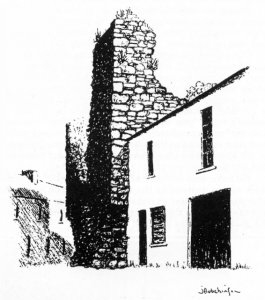 |
The Bann may flood its winding
banks,
Near the Castle of Dromore;
Yet no ill thing shall come between,
My babe and my heart's core.
The little folk will smile on you,
From eve till morning's dew;
Sleep hush-a-by loohan, lo-lo-lan,
Sleep hush-a-by-lo, lo-lan:' |
|
It seems that the above song
has no connection with our Castle or Town.
Rather, evidence suggests that it concerns a
Dromore elsewhere in Ireland. However, in the
absence of any other song about our home-town,
local folk may be forgiven for adopting it as
their own. There is no doubt that it is a
beautiful, if plaintive, lullaby. |

History of the County Down-The Local Connection
by WILL PATTERSON In 1875 "A History of the
County Down" appeared. This was a comprehensive volume which
detailed 'from the most remote period to the present day'.
An account of the early history, geography, topography,
antiquities and natural history of the County. Its author
was an Alexander Knox MD and it is of interest to find that
he was born near Dromore.
Alexander Knox was born at Eden Hill House, Edentrillick in
1802. His brother George, already a successful wine merchant
in Belfast, became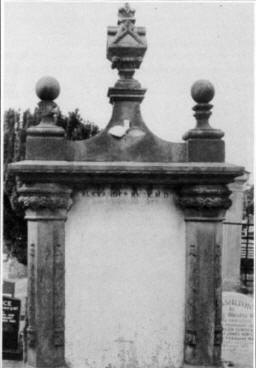 even more successful as a planter in Jamaica. Alexander
studied medicine at Edinburgh, graduating in 1831. He gained
further experience in the Royal Navy as an assistant surgeon
before settling down to practice at Dromore in his native
County. About 1840 he moved down to Ballycastle, Co. Antrim,
where he built up a successful practice before illness
forced him to give up medicine. Moving to Belfast he took up
residence at 6 College Square East. To benefit his health he
was advised to go on a long sea voyage, but instead he set
out to visit and comment on the mineral waters of Ireland.
This resulted in his writing his first book, "Irish Watering
Places". This fine and rare book was published in
even more successful as a planter in Jamaica. Alexander
studied medicine at Edinburgh, graduating in 1831. He gained
further experience in the Royal Navy as an assistant surgeon
before settling down to practice at Dromore in his native
County. About 1840 he moved down to Ballycastle, Co. Antrim,
where he built up a successful practice before illness
forced him to give up medicine. Moving to Belfast he took up
residence at 6 College Square East. To benefit his health he
was advised to go on a long sea voyage, but instead he set
out to visit and comment on the mineral waters of Ireland.
This resulted in his writing his first book, "Irish Watering
Places". This fine and rare book was published in
Dublin in 1845.
Doctor Knox then returned to medical practice, this time in
Strangford, Co. Down. He became seriously concerned at the
prevalence of cholera and wrote a number of scientific
papers on this subject in the Dublin Medical Press in
1847-48. In 1849 he expanded these into his second book "An
enquiry into the Actual State of our Knowledge of Cholera"
which was published in Dublin. In 1851 he was appointed Poor
Law Medical Inspector and in 1853 was elected a member of
the Belfast Clinical and Pathological Society.
For two decades Alexander Knox MD continued to practice in
Strangford, retiring in 1871. He then moved back to Belfast
to live at Beechcroft House, Strandtown. At this point he
began to gather material for his greatest work, "A History
of County Down" which was published in 1875.
Two years later, on the 9th November 1877, Doctor Knox died
at his home and was buried in the Cathedral graveyard in
Dromore.

SOME ARE GONE,
BUT NONE ARE FORGOTTEN
by JIM HUTCHINSON The following
are some local places which have either disappeared
altogether or their names are fading from common usage. The
locations given are as I have understood them to have been,
but I am open to correction.
| THE BLACK BOX: A tarred,
wooden aqueduct that has now gone. It once carried
the millrace to Hamilton, McBride's factory across
the Lagan, behind 'Otter Lodge'. |
| PEGGY'S PUMP: This
once stood between No. 39 Circular Road and the
junction with the Dromara Road. |
| THE WYRE STONES: A
weir on the Lagan where it passes the Mount.
This has now been breached. |
| SCOTT'S ENTRY :
A covered gateway opposite McGrehan's
shop in Meeting Street, that gave access
to the rear of Nos. 24 & 26 Meeting
Street and various stores and
out-houses. This has disappeared in
recent re-development of the area. |
| "THE ROCKS" :
The local name for Castle Street,
which passes the old Castle. |
| THE
TURNPIKE HOUSE : This once
stood on the town side of the
High School, where Nos. 27 & 29
Banbridge Road now stand. |
| THE
SHILLING (OR SHELLING) HILL:
A laneway which ran from
Church Street down to the
Lagan, between the Cathedral
Church Hall and R. J.
Tinsley's property. |
|
THE STATION HILL:
The part of upper Church
Street leading to the
old railway station. |
|
THE EAGLE GATES :
The entrance gates
to Quilly House from
the Lower Quilly
Road. There are two
stone birds mounted
on the pillars. |
|
PURGATORY :
A pleasant
walk-way running
between the
Lurgan Road and
the Lower Quilly
Road, passing
through Mill
buildings. |
|
THE GLEN
: A
rural
laneway that
stretches
between the
Lower Quilly
Road and the
Rowantree
Road. |
|
CREIGHTON'S
YARD :
Waste
ground
off Moss
Lane.
Now
occupied
by
Graham's
concrete
works. |
|
'THE
BOWLING
GREEN":
The
local
name
for
the
low,
rectangular
mount
(Bailey)
at
the
top
of
Mount
Street. |
| INN GARDENS : The name of houses that ran from Cross Lane to the rear of properties fronting on the Square. Now forms part of the Cross Lane car park. |
| McQUAIDE'S ROW : The name of the row of old houses on Hillside. Now re-developed. |
| BROWN'S (OR THE PRIEST'S) MOUNT: Local name for the Rath on Maypole Hill. |
| SPENCE'S COURT: The name of houses off Gallows Street. They were situated in front of Bradshaw's shop and access was by means of a covered entryway in the row of houses fronting on Gallows Street. They have now disappeared due to re-development. |
| 'THE M. ONE" : The local name for the pedestrian way created between Gallows Street and the Hillsborough Road in the 1950's. It ran down by Weir's Side Row and came out by the Orange Hall. Although the area has been re-developed, a pedestrian way still exists at this point. |
| 'THE CUT': A laneway from the top of Gallows Street Hill down by the side of Jubilee Park coming out by the side of number 17 Hillsborough Road. |
| THE BRICKFIELD' : The field adjoining the "cut". Stretching from the top of Gallows Street to the Hillsborough Road. Where Mourneview Park was subsequently built. |
| THE MILLTURN : The junction of the Banbridge Road and the Lower Quilly Road. On the right-hand side, just past the High School. |
| 'THE DIRTY GUTTER": An old, local name for Jubilee Road. |
| THE SPOUT LOANEN : The local name for the road which stretched from the Milebush Road to the Connolystown Road. In spite of partial re-routing caused by the construction of the Dromore bypass, most of this still survives and is now the Maypole Road. |
| 'THE DANDYCAPS' : Old, local name for the junction of the Hillsborough Road and the Ballymacormick Road. |
| "THE RAMPER" : The out-of-town side of the Maypole Hill. |
| DICKSON'S COURT : Entryway off the Square. Running between Nos. 22 & 25 Market Square. |
| THE OLD COACH ROAD : The vestiges of this, by now an overgrown laneway, could be seen stretching from the Ervine Memorial Hall, Rampart Street to the rear of the Rugby Field on Barban Hill. It has probably been encroached upon by new housing development in the area. |
| 'THE WEST END": The junction of Meeting Street and Rampart Street. Possibly because it is the West end of Meeting Street. |
| "THE MILLS": The old Mill buildings have gone and the site forms part of the new town Park, off the Banbridge Road. |
| 'THE LOW MILLS" : Mill buildings off the Lurgan Road. Situated on the Lagan, downstream of Holm Terrace. |
| 'THE FACTORY': Locally the general term for Holm Factory and Holm Terrace. |
| 'THE KEEP LEFT' : A traffic bollard that stood in Church Square facing the Cathedral. This has now been replaced by a "stud" roundabout. |
| THE QUILLY BURN: Where the Banbridge Road joins the dual-carriage way to the South of the town. |

|
DROMORE'S GOLF CLUB According to a book on Early Irish Golf, Dromore could once boast of having a golf course of its own! A newspaper report on the 10th January 1896, records the recent formation of a golf club in the town and is quoted as follows: "A new Irish club has been formed at Dromore, Co. Down. To be called the Dromore Club . . ." The President is given as Lord Arthur. Vice Presidents were Rt. Rev. Monsignor McCartan, Rev. Eamon Hayes and John R. Miniss. Captain was William Preston. The Golfing Annual 1895/96 states that the club was "instituted 28th November, 1895, the course, of nine holes, is situated on the old Loyola grounds . .
"When the order of Jesuits owned and occupied the old Bishop's Palace, they called it Loyola House. After their founder Saint Ignatius Loyola. The club is listed in The Golfing Annual 1907/08 and in The Irish Golfer's Guide 1910, the club is recorded as 'believed to be extinct.' |

THE RACECOURSE
by F G. WATSON
The peace and tranquility normally associated with the quiet
fields that stretch along the river Lagan would regularly be
disturbed by the bustle and throng of people attending the
race-meetings. Since the 18th century the tenants on the
Watson farms on the Cockhill Road and Dunnygarton Lane would
have been subjected to the influx of visitors and travellers
from all over Ireland converging on the race course. On main
roads and bye roads, they came on horse and on foot and in all
types of transport from splendid coaches, gigs and traps to
the tradesman's cart specially fitted up for the occasion.
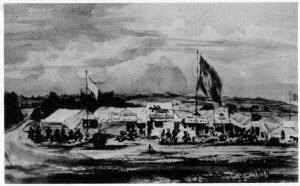 |
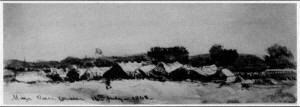 |
|
The gifted amateur James Moore M.D.
Hon. R.H.S. (1819-1883) provides us with two
accomplished and vivid watercolour sketches of the Maze
racecourse
dated August 3rd 1852, and 14th July 1868.
Reproduced by permission of the Ulster Museum |
Dunnygarton Lane meandered through the course itself and it is
easy to imagine the carnival atmosphere that would prevail on
the occasion of a holiday in the general area with excitement
for rich and poor alike. Farmer, weaver, artisan and labourer
would mingle with the Gentry on these great occasions as they
headed for the colourful flag bedecked tents of the stewards,
saddlers, fortune tellers, gambling side shows and taverns.
The origins of the course are much older as a patent to
establish a Corporation of Horsebreeders for Down had been
granted by James II and the racecourse at Downpatrick had been
formed in 1685. When William III, the Prince of Orange,
visited Hillsborough Castle as the guest of William Hill he
issued a letter to Christopher Carleton the Collector of
Customs at Belfast granting �100 to be known as the Kings
Plate and to be competed for at Hillsborough.
William Hill established the course at the Maze and his heir
the Right Honourable Michael Hill implemented improvements and
took a keen interest in racing blood stock. Walter Harris
writing in 1744 gives us a brief description of the course.
"The Maze-Course, a place set apart for the publick diversions
of horse racing, is upwards of a mile North of the town, near
the banks of the River Lagan. A rising hill in the middle of
the course, about two miles in circumference, give the
spectators a full view of the whole field, and on the top of
the hill a wooden tower is erected, open on all sides, for
spectators to sit and view the course."
This original tower or stand was a wooden structure but was
replaced by a round white washed stone tower on Tower Hill.
The original hill formed a natural vantage point for the
spectators and in earlier times it was not unusual for them to
cut a flat hearth into the slope and cook over a lighted fire
while they viewed the races.
The slope of the ground was the cause of many a fall as the
crowd surged forward with excitement to see the closing stages
of a race. Just before the races in July 1775 Mr Perfect an
itinerant Methodist Minister preached at Halftown and during
the sermon warned his congregation not to attend the
racecourse, which was the scene of so many crimes and numerous
calamities. The following eye witness account is provided by
Patrick Cunningham who ignored the warning (horse racing being
his favourite sport) but refrained from attending the Sunday
races.
"The first day of the races presented a most shocking scene
perhaps not less than one hundred thousand people all
confusion and uproar. This was occasioned by a quarrel between
the men of Broomhedge and those of Hillsborough. They armed
themselves with whatever weapons they could get, and rushed
upon each other with the ferocity of wild beasts, and fought
with the greatest desperation. Such rage and clamour I never
witnessed before. In a little time many of them were weltered
in their own blood. I remember one only killed on the spot,
but several died afterwards of their wounds."
Cunningham's assessment of the crowd is questionable but the
racecourse was at its peak between 1811 and 1825 and its
patrons included Lord Castlereagh, The marquis of Downshire,
The Marguis of Donegall, Lord Portarlington, Lord O'Neill.
Colonel Sparrow of Tandragee Castle, Colonel Cope of
Loughgall, J. W. Maxwell, Nicholas Price, Colonel Forde. Sir
S. May, Sir Robert Bateson, Messrs Whaley, McCance, Savage,
Batt, Verner, Greg, Martin, Fivey, Moore, Nugent, Hall and
Shaw indeed the men of note in the province.
James Watson Esq. of Brookhill was a popular leading huntsman
and local contestant at both Downpatrick and the Maze. His
last race at the Maze was on 12th October 1825 when he
competed for the County Cup on a twenty year old favourite of
his called Violet. He was at this time over 60 years old and
retired as a winner. Jockeys were used at the course but in
addition Gentlemen such as Watson and his brother-in-law Mr.
Wakefield rode their own horses.
Over the years the standing of the Maze as a Social occasion
reduced as it was plagued by criminal elements both male and
female. Personal attacks and robbery were identified with the
periodical meetings and on a further occasion murder, despite
the efforts of the Marquis of Downshire. This occurred when a
serious fight developed and the Marquis of Downshire attempted
to defuse the situation by having one of the ruffians removed
from the ground in his own carriage. The man a strong powerful
individual was incensed by his Lordship's action and breaking
loose jumped from the carriage and returned to the affray
where he was stabbed to death. When his pregnant wife was
informed she took ill and also died.
Race days would have been exciting times for the Watson
families of the area as they punctuated the routine of the
working year. With the crowds departed the fields would resume
their quiet peaceful form, just as they remain to-day for
Mamie Hewitt nee Watson whose house overlooks the course, and
very much the same as they were when Richard Watson tended his
cow and paid one shilling for grazing rights as is recorded in
an account of grazers on the Maze Course in year 1777.

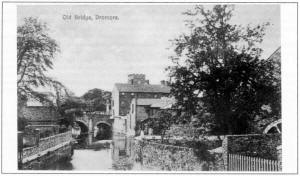 |
|
Old Bridge Dromore |
THE 'CAVE' - FOUND AND LOST AGAIN In "A Ramble through Dromore" J. F Mulligan tells us about the discovery in 1823 of a cave near the old castle by workmen engaged in quarrying in the area. They uncovered a circular opening some 3 feet in diameter which had been wedged with large stones. This aperture led to a long underground passage 24 feet long by 2 feet 6 inches wide, which had been hewn in the solid rock. This 'cave' proved to be an ancient burial chamber, containing bones and other matter. At the time the discovery was reported in the Belfast News-Letter which concluded it's report with "It is not improbable that the cave ... was the burying-place of St. Colman". Be that as may, it was certainly the tomb of some important personage. Since it's discovery in 1823, it would seem to have been lost again. From the details given ("to be within 12 yds. of the old castle and on the top of the rock") it is impossible to determine it's exact location today. The Historical Group would be interested in learning more about the whereabouts and subsequent fate of this 'cave'. Any information would be welcomed by the editorial committee.
 |